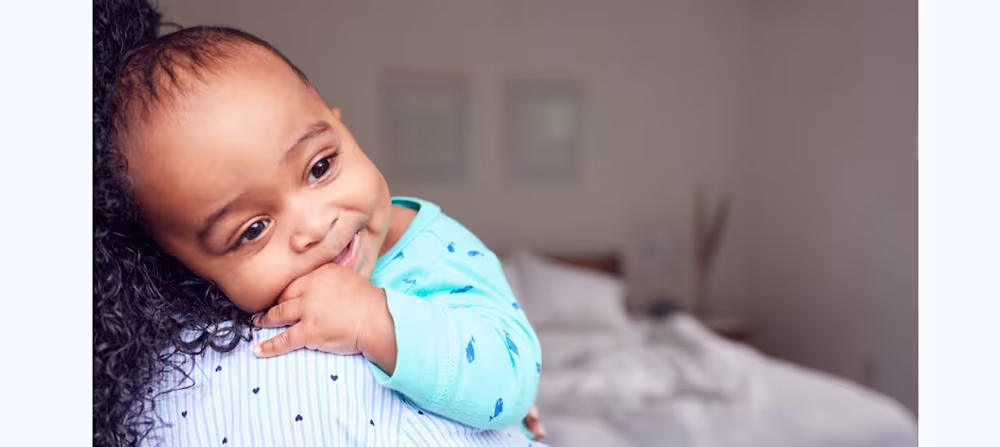Baby feeding tube: What is it?
Updated Oct 17, 2025

Babies need breast milk or formula to grow and develop. Sometimes, usually when they’re born prematurely or have a health condition, they aren’t able to eat enough on their own. In these cases, your baby may need to be fed through a feeding tube. []
A feeding tube for babies is just like an adult feeding tube – it’s a small tube that’s placed into the baby’s stomach and allows for food (in the case of babies: breast milk or formula) and medications to enter. Feeding tubes are commonly used as a temporary tool and they can be life-saving – ensuring your little one gets all the nutrition they need to thrive.
Types of baby feeding tubes
There are several different types of feeding tubes for babies that may be used depending on the situation and your baby’s needs. []
Nasogastric tube (NG tube)
A nasogastric tube, commonly known as the “NG tube,” is one of the most common types of feeding tubes for babies. The NG tube is a thin, soft tube that goes in through the nose and down the throat into the stomach. It’s taped to the side of your baby’s face, near their nose. []
Orogastric tube (OG tube)
An orogastric, or OG, tube is very similar to the NG tube (soft, flexible, and thin), but goes in through the mouth, rather than the nose. Most babies are discharged home with NG, NJ, G, or GJ tubes. Orogastric tubes are typically only used when inpatient.
Nasojejunal (NJ tubes)
A nasojejunal, or NJ tube, is similar to a NG-tube. The difference is that it’s inserted through the nose and past the stomach into the baby’s small intestine, or the jejunum. NJ tubes are usually recommended when babies cannot tolerate food in their stomach and benefit from nutrition going straight to their intestines. NJ tubes are typically used with babies who will likely only need it temporarily.
Gastronomy tube (G-tube)
A gastronomy tube, or G-tube, is similar to the NG tube, except the tube is surgically placed directly into the baby’s stomach through their abdomen. Depending on what’s needed, the G-tube is placed either through small incisions like laparoscopic surgery or larger incisions like open surgery. These tubes are typically used for babies who need tube feeding for a longer period, especially in hospital settings. []
Jejunostomy tube (J-tube)
A jejunostomy, or J-tube, is similar to a G-tube in that it’s surgically inserted directly through the skin into the baby’s digestive system. However, while a G-tube is inserted into the baby’s stomach, a J-tube is inserted into the small intestine.
Reasons for using a baby feeding tube
Doctors recommend that babies use feeding tubes when they aren’t able to safely or comfortably eat enough by mouth. Babies need a lot of important nutrients and calories, as well as medications if needed.
If they’re not able to meet their nutritional needs on their own, then a feeding tube is an important tool to make sure the baby gets the nutrition they need to grow. Feeding tubes save many babies’ lives!
Some of the most common reasons why some babies use feeding tubes include:
The baby is unable to breastfeed or bottle-feed due to prematurity or illness. It takes strength and coordination for babies to be able to breast- or bottle-feed on their own. Many preterm babies, as well as babies born with other health conditions that require them to be hospitalized after they are born, are tube-fed for this reason.
There is a lack of sucking ability or swallowing reflex. If the baby is unable to suck or swallow safely on their own, then tube-feeding may be necessary to make sure the baby is well-nourished.
The baby has gastrointestinal or respiratory issues. Some other health conditions can also make it very difficult for babies to eat on their own. For example, gastroesophageal reflux disease, constipation, motility problems, allergies and intolerances, esophagitis, gastritis, viral or bacterial infections, chronic respiratory illnesses, and others can all lead to needing a feeding tube. []
Feeding tubes are usually a temporary measure until your baby is physically ready and has enough endurance to be a full oral feeder.
Managing a baby feeding tube at home
If your baby needs a feeding tube, then they’ll receive one initially at the hospital. In some cases, if your baby’s health is stable other than needing the feeding tube, doctors may decide it’s safe for you and your baby to go home together while the feeding tube is still in place.
How your care plan works, and whether or not you and your little one are sent home with a feeding tube, is something that varies widely depending on the hospital and your child’s specific care plan developed with your provider. [] Some hospital protocols might keep your baby in the hospital until they no longer need a feeding tube, while others (depending on the health system) could send you home and instruct you on how to manage tube feeding at home.
If you and your new baby do get discharged with a feeding tube, how you manage your baby’s feeding tube will depend on the feeding method that’s used. Some babies may have their feeding tube connected to a feeding bag or syringe which drips breastmilk or formula slowly using gravity, and some will need a pump which helps control how fast the food goes into the baby’s stomach. In some instances, an in-home nurse may come to check on your baby’s feeding tube. You can also use the to track feeds and write notes about them.
No matter the situation, the most important thing is to follow your provider’s instructions exactly – and call them if you’re ever unsure about anything. Always wash your hands with soap and water or an alcohol-based sanitizer before using or touching the tube. Keeping your baby’s feeding tube clean is crucial to prevent infections.
Seeking medical advice and support
Your provider will instruct you on how to check whether you’ve inserted the NG tube correctly – the process usually involves taking a sample to make sure you get gastric fluid (to be sure the feeding tube hasn’t gone into your baby’s lungs). []
If your baby is coughing, turning blue, or gagging after placing an NG tube, it may not be in the right spot. Remove their NG feeding tube immediately. [] Feeding tubes can sometimes be awkward or uncomfortable for babies, but they should never be painful. Never force the feeding tube.
If you’re ever concerned about the placement of the feeding tube or whether it’s being used correctly, call your baby’s medical provider right away or go to your local urgent care or emergency room. Feeling confident and comfortable with your baby’s feeding tube is important.
Takeaway
Many parents or caregivers feel nervous about baby feeding tubes and that’s completely understandable! You can rest assured that, in general, feeding tubes for babies have very little risk when used correctly. Tube feeding is not just an essential tool for ensuring babies get the nutrition they need to grow and thrive, but just as importantly it helps protect the oral feeding foundation and promote oral feeding progression if and when a baby is medically and developmentally ready. It is a tool to keep oral feeds safe and positive. This is key for helping set babies up for success with oral feeding.
If you’re ever concerned about your baby’s feeding tube, don’t hesitate to talk to your medical provider. They can help answer any questions and make you feel more confident in your baby’s feeding plan.
Baby feeding tube FAQ
Share article:
Note: The content on this site is for informational purposes only and should not replace medical advice from your doctor, pediatrician, or medical professional. If you have questions or concerns, you should contact a medical professional.
8 Sources
Share article:








